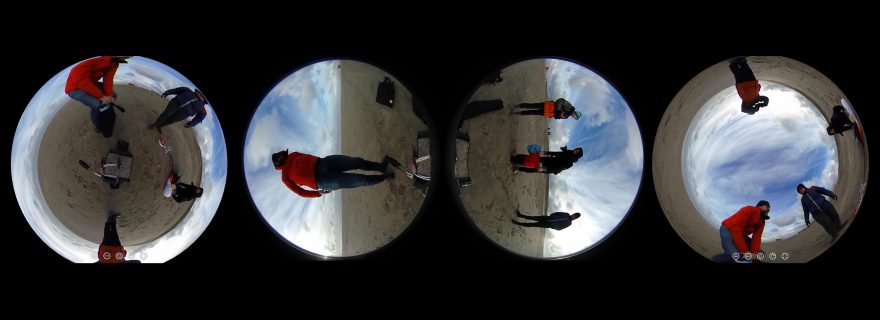The Leiden School of Multimodal Ethnography?
In this blog, Mark Westmoreland provides some insights into how the Institute of Cultural Anthropology and Development Sociology at Leiden University engages with multimodal teaching & research. This is part 2 of a blog series on multimodal anthropologies.
In part 1 of this blog series on Multimodal Ethnography, I provide a gloss of some of the key issues transforming visual anthropology and other practice-based disciplines. With these critical points in mind, the team of visual anthropologists at Leiden University has been working to re-envision and redesign the visual ethnography program in ways we hope will inspire students and staff to experiment with cutting-edge multimodal approaches.
Visual Ethnography Specialization
Our program builds upon the legacy of innovation and commitment to combining methodologies from visual ethnography and material culture, particularly in the context of public display and archival collections in ethnographic museums. This unique approach initiated by Adriaan Gerbrands and developed by Dirk Nijland and others has come to be known as the Leiden School of Visual Ethnography. The reputation of this school of thought has attracted many students to Leiden to do advanced training in camera-based research methods. Today, we are attracting more students than ever by coaching them to develop skilled research practices, think creatively with a camera, and experiment with multimodal approaches.
Beginning next year, Visual Ethnography will become its own master’s specialization. When students arrive in Leiden they will benefit from our comprehensive effort to redesign the way we teach visual ethnography. With two FSW Grassroots teaching innovation grants (and other applications submitted), we have begun designing, developing, and building an extensive instructional program that features ethnographic applications in drawing, photography, video, and sound. Our media enhanced modules provide a complete instructional package, including video lectures, readings, viewings, exercises, and assignments.
We have developed these multimodal online learning resources to provide students a foundation of theoretical knowledge and a structure for developing empirical research skills. By completing these foundational lessons in advance, thereby ‘flipping the classroom’, we aim to provide more individual and small group support during class-time with intensive hands-on exercises and interactive feedback by both peers and instructors. By rehearsing with the tools and techniques in these preparatory modules, students are well-prepared to begin their intensive period of fieldwork and establish research practices that are critically embedded in methodological frameworks for producing relational knowledge with local collaborators in the field.
Field Schools
Our current cohort of students in the program have just completed the first part of this pilot training phase and are now preparing to leave for their field research. Staff is also preparing to go to the field. At the Ghana Field Research & Training (FR&T) program, Sabine Luning and I will collaborate on a project with local partners in an effort to develop multimodal collaborative research projects in conjunction with our Ghana field school. Supported by the Center for Innovation, we have developed a multimodal project to re-visualize the landscapes of small scale gold mining by experimenting with a range of practices including DIY aerial photography, 360-degree video, sonic recordings, and ‘flat’ video!
Our international network also includes the Netherlands Institute in Athens, where Metje Postma and I contribute to their intensive summer course in Visual Ethnography of Cityscapes taught in collaboration with Greek anthropologists and artists. This field school offers advanced students the opportunity to conduct intensive research in one of the most dynamic cities in Europe and produce a short film for consideration in Ethnofest. Many of the participants have continued their visual ethnography pursuits in our master’s program as this program fulfills prerequisites for visual methodology training.
Film Festivals
Several of our students have been quite successful at getting their films recognized at international festivals. Upon completion of the master’s program, we prepare students for the festival spotlight by premiering graduating films and multimodal projects at our Kijkhuis mini-festival. This October audiences were treated to a diverse collection of films made in Aruba, Egypt, Greece, Ghana, South Africa, and the Netherlands. But the festival circuit is not the end of the line. In an effort to extend the reach and impact of student research, we are currently exploring opportunities of make these works more accessible through online streaming packages. While navigating the material and conceptual limitations of contemporary academic publishing mentioned in the previous post, this effort to make ethnographic films accessible to wider audiences reflects our commitment to giving multimodal research greater academic and public impact.
The Future of Visual Ethnography
While students have further cultivated their training by pursuing PhD positions and other exciting opportunities, one of the most inspiring recent applications of our visual ethnography approach has been the partnership of five students from the class of 2016 who have recently formed a business called ethnovision. They aim to collaborate with researchers to help them raise awareness and facilitate discussion about significant social-political issues. In other words, by producing audiovisuals outputs that offers a variety of ways for understanding dynamic issues, ethnovision will help partners translate their research for broader publics.
Like these graduates, students in our program are well prepared to employ multimodal and practice-base research practices that contribute to crucial scholarly and social debates. Giving the changing paradigms of scholarship, anthropologists and other social scientists would do well to incorporate ethnovision’s expertise. In order to reach its fullest potential, experimental innovation should be informed by rigorous training in the analytical mediation of ethnographic realities and draw from deep genealogies of theorizing such practices. That’s our aim!
This is part 2 of Mark Westmoreland's blog series on multimodal ethnography. Read part 1: 'Multimodal Anthropology?'



0 Comments
Add a comment